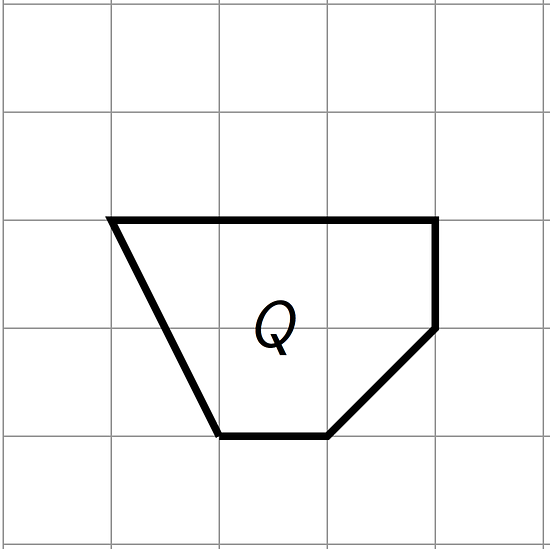Lesson 6Scaling and Area
Let's build scaled shapes and investigate their areas.
Learning Targets:
- I can describe how the area of a scaled copy is related to the area of the original figure and the scale factor that was used.
6.1 Scaling a Pattern Block
Use the applets to explore the pattern blocks. Work with your group to build the scaled copies described in each question.

- How many blue rhombus blocks does it take to build a scaled copy of Figure A:
-
Where each side is twice as long?
-
Where each side is 3 times as long?
-
Where each side is 4 times as long?
-
- How many green triangle blocks does it take to build a scaled copy of Figure B:
-
Where each side is twice as long?
-
Where each side is 3 times as long?
-
Using a scale factor of 4?
-
- How many red trapezoid blocks does it take to build a scaled copy of Figure C:
-
Using a scale factor of 2?
-
Using a scale factor of 3?
-
Using a scale factor of 4?
-
- Make a prediction: How many blocks would it take to build scaled copies of these shapes using a scale factor of 5? Using a scale factor of 6? Be prepared to explain your reasoning.
6.2 Scaling More Pattern Blocks
Your teacher will assign your group one of these figures, each made with original-size blocks.

-
In the applet, move the slider to see a scaled copy of your assigned shape, using a scale factor of 2. Use the original-size blocks to build a figure to match it. How many blocks did it take?
-
Explain why doubling the blocks was not enough to match the scaled copy, even though the scale factor was 2.
-
Move the slider to see a scaled copy of your assigned shape using a scale factor of 3. Start building a figure with the original-size blocks to match it. Stop when you can tell for sure how many blocks it would take. Record your answer.
-
Predict: How many blocks would it take to build scaled copies using scale factors 4, 5, and 6? Explain or show your reasoning.
-
How is the pattern in this activity the same as the pattern you saw in the previous activity? How is it different?
-
Discuss your answers with another group that worked on the same shape until you reach an agreement. Be prepared to share your reasoning with the class.
Are you ready for more?
-
How many blocks do you think it would take to build a scaled copy of one yellow hexagon where each side is twice as long? Three times as long?
-
Figure out a way to build these scaled copies.
-
Do you see a pattern for the number of blocks used to build these scaled copies? Explain your reasoning.
6.3 Area of Scaled Parallelograms and Triangles
- Your teacher will give you a figure with measurements in centimeters. What is the area of your figure? How do you know?
- Work with your partner to draw scaled copies of your figure, using each scale factor in the table. Complete the table with the measurements of your scaled copies.
scale factor base (cm) height (cm) area (cm2) 1 2 3 - Compare your results with a group that worked with a different figure. What is the same about your answers? What is different?
- If you drew scaled copies of your figure with the following scale factors, what would their areas be? Discuss your thinking. If you disagree, work to reach an agreement. Be prepared to explain your reasoning.
scale factor area (cm2) 5
Lesson 6 Summary
Scaling affects lengths and areas differently. When we make a scaled copy, all original lengths are multiplied by the scale factor. If we make a copy of a rectangle with side lengths 2 units and 4 units using a scale factor of 3, the side lengths of the copy will be 6 units and 12 units, because and .

The area of the copy, however, changes by a factor of (scale factor)2. If each side length of the copy is 3 times longer than the original side length, then the area of the copy will be 9 times the area of the original, because , or , equals 9.

In this example, the area of the original rectangle is 8 units2 and the area of the scaled copy is 72 units2, because . We can see that the large rectangle is covered by 9 copies of the small rectangle, without gaps or overlaps. We can also verify this by multiplying the side lengths of the large rectangle: .
Lengths are one-dimensional, so in a scaled copy, they change by the scale factor. Area is two-dimensional, so it changes by the square of the scale factor. We can see this is true for a rectangle with length and width . If we scale the rectangle by a scale factor of , we get a rectangle with length and width . The area of the scaled rectangle is , so . The fact that the area is multiplied by the square of the scale factor is true for scaled copies of other two-dimensional figures too, not just for rectangles.
Lesson 6 Practice Problems
On the grid, draw a scaled copy of Polygon Q using a scale factor of 2. Compare the perimeter and area of the new polygon to those of Q.

A right triangle has an area of 36 square units.
If you draw scaled copies of this triangle using the scale factors in the table, what will the areas of these scaled copies be? Explain or show your reasoning.
scale factor area (units2) 1 36 2 3 5 Diego drew a scaled version of a Polygon P and labeled it Q.

If the area of Polygon P is 72 square units, what scale factor did Diego use to go from P to Q? Explain your reasoning.
Here is an unlabeled polygon, along with its scaled copies Polygons A–D. For each copy, determine the scale factor. Explain how you know.

Solve each equation mentally.